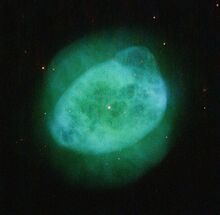Astronomy:IC 289
From HandWiki
Short description: Nebula in the constellation Cassiopeia
| Emission nebula | |
|---|---|
| Planetary nebula | |
 As seen by Hubble | |
| Observation data: J2000.0 epoch | |
| Right ascension | 03h 10m 19.3017s[1] |
| Declination | +61° 19′ 00.914″[1] |
| Distance | 5,190 ± 500 ly (1,592 ± 153 pc)[2] ly |
| Constellation | Cassiopeia |
| Designations | IRAS 03062+6107, 2MASS J03101930+6119009, ARO 86, Hb 1, VV 9, RL 67, Lan 496, NSV 1056, GSC2 N313033135782[1] |
IC 289 is a planetary nebula in the constellation Cassiopeia.[3] It was discovered by Lewis Swift in early September 1888. It lies close to the 10th magnitude star BD +60° 0631. N.J. Martin described IC 289 as "A nice, faint round planet like planetary nebula. The uniform oval disc shows some irregularity in brightness but is not obviously brighter at the edge."[citation needed]
The central star of the planetary nebula is an O-type star with a spectral type of O(H).[4]
References
- ↑ 1.0 1.1 1.2 "IC 289". SIMBAD. Centre de données astronomiques de Strasbourg. http://simbad.u-strasbg.fr/simbad/sim-basic?Ident=IC+289.
- ↑ Brown, A. G. A. (August 2018). "Gaia Data Release 2: Summary of the contents and survey properties". Astronomy & Astrophysics 616: A1. doi:10.1051/0004-6361/201833051. Bibcode: 2018A&A...616A...1G.
- ↑ IC 289
- ↑ González-Santamaría, I.; Manteiga, M.; Manchado, A.; Ulla, A.; Dafonte, C.; López Varela, P. (2021). "Planetary nebulae in Gaia EDR3: Central star identification, properties, and binarity". Astronomy & Astrophysics 656: A51. doi:10.1051/0004-6361/202141916. Bibcode: 2021A&A...656A..51G.
External links
 |

